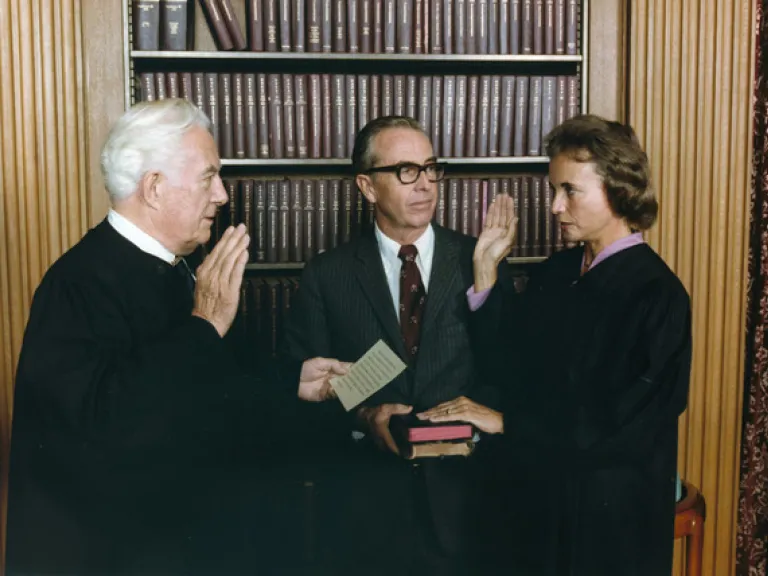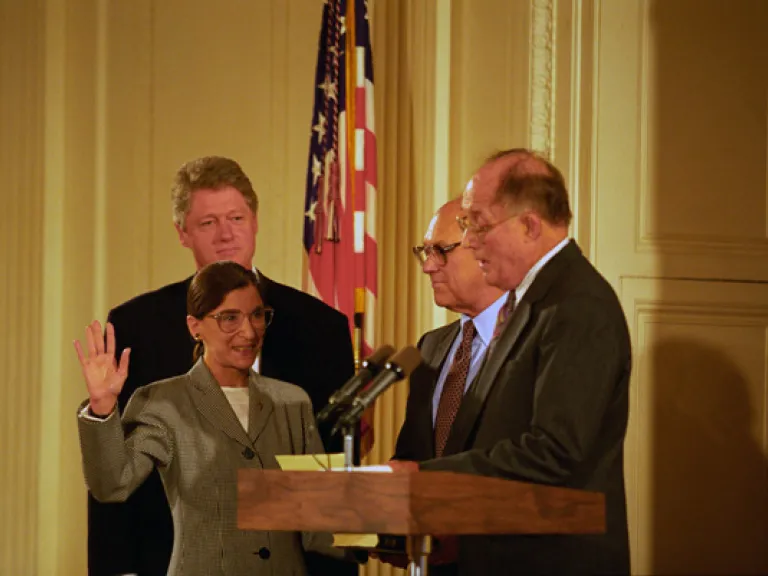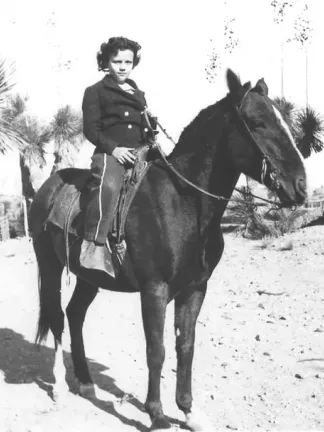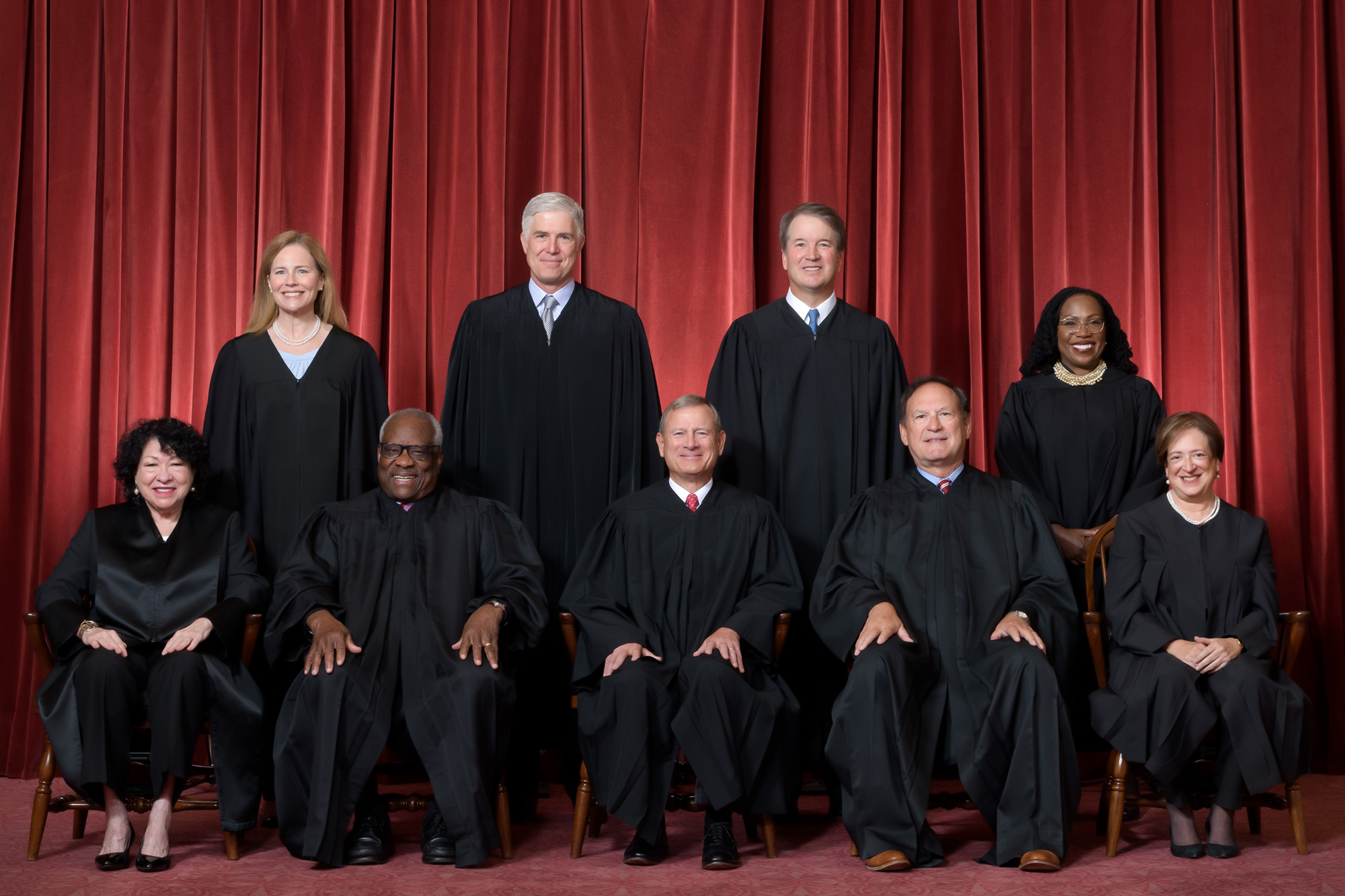Pop Civ is a series developed by the John Marshall Center for Constitutional History & Civics at the VMHC. By connecting current events and popular culture with historical events, these articles and discussion questions provide classrooms and the general public with valuable context to consider our civic legacy. View all Pop Civ articles.
Sisters in Law: Justices Sandra Day O’Connor and Ruth Bader Ginsburg
From its inception in 1789 until the arrival of Sandra Day O’Connor in 1981, America’s highest court was an exclusively male institution. While the 20th century saw women make their way onto the bench in courtrooms across the nation, by 1980 only 17 percent of American judges were female. President Ronald Reagan’s decision to nominate O’Connor to the position of Associate Justice helped make way for a new era on the Court.
Sandra Day O’Connor

Sandra Day O'Connor being sworn in as Supreme Court Justice by Chief Justice Warren Burger as her husband John O'Connor looks on at the US Supreme Court. Photo credit: Reagan White House Photographs
Born in 1930, Justice O’Connor began her life as Sandra Day, the daughter of ranchers who lived in the Southwest. A precocious student, she entered Stanford University at the age of 16 to pursue an undergraduate degree in economics, graduating Magna Cum Laude in 1950. She resumed her studies at Stanford in 1952 to pursue a law degree, where she served on the Stanford Law Review (with, coincidentally, her future Chief Justice, William Rehnquist) and was a member of the Order of the Coif, indicating her position as part of the top ten percent of her class.
After graduating in 1952, Day married John Jay O’Connor III, a fellow Stanford alum. As a woman, O’Connor struggled to find a position in a traditional law practice. She worked for a time without pay as a deputy county attorney in San Mateo, CA, but eventually drew a salary after several months in the role. After traveling to Germany for her husband’s job in the Judge Advocate General’s Corps and her own volunteer position with the Army’s Quartermaster’s Corps, the O’Connors settled in Arizona, where Sandra began volunteering for political campaigns in the state. O’Connor went on to serve as Arizona Assistant Attorney General from 1965-69 and was appointed to the state’s Senate in 1969. By 1973, she had become the nation’s first female State Senate Majority Leader. In 1974, O’Connor was elected to the Maricopa County Superior Court and was elevated to the Arizona Court of Appeals in 1979.
History was made when President Reagan nominated O’Connor to the Supreme Court in 1981, fulfilling his campaign promise to put a woman on the highest court of the land. While many welcomed the idea of having a female justice, right-wing groups were concerned that O’Connor, who had gained a reputation in Arizona as a moderate, would not be conservative enough. The issue of abortion loomed large in her Senate Judiciary Committee confirmation hearing, the first ever of its kind to be televised. Eventually, the Senate confirmed O’Connor with a vote of 99-0.
O’Connor proved to be the strong moderate many had predicted. While she tended to vote more conservatively early in her tenure, often siding with Chief Justice and former classmate Rehnquist. As the makeup of the court shifted towards the right, her vote shifted towards the middle. O’Connor frequently was the swing vote in Court decisions.
Ruth Bader Ginsburg

Chief Justice William Rehnquist swearing in Ruth Bader Ginsburg as an Associate Justice of the Supreme Court while President Bill Clinton and Ginsburg’s husband, Martin Ginsburg, look on, 8/10/1993.
Joan Ruth Bader was born in 1933 in Brooklyn, NY, to a Polish-Ukrainian Jewish family living in the Flatbush neighborhood. Spurred by her mother’s hopes that her daughter would go further with her education than she herself had, Ruth was an avid student and entered Cornell University at age 17. There she met her future husband, Martin Ginsburg, and went on to be the highest-ranking graduate of the Class of 1954. After their graduation, the Ginsburgs relocated to Oklahoma, where Martin was stationed in the U.S. Army Reserves. There, Ruth worked for the Social Security Administration but was demoted when her supervisors learned she was pregnant with her first child.
In 1956, Ginsburg enrolled in Harvard Law School, where the gender gap was starkly evident. Only one of nine women in a class of 500, Ginsburg and her female classmates were reportedly asked by the Dean of the School why they were at Harvard Law, taking the place of men. Ginsburg would wind up transferring to Columbia Law School following her husband’s move to a new job and would become the first woman to serve on two major law reviews (Harvard Law Review and Cornell Law Review).
Like O’Connor, Ginsburg struggled to find paid positions in the legal profession following her graduation in 1959. Despite tying for first in her class, she was rejected for a clerkship under Supreme Court Justice Felix Frankfurter because she was female. Instead, she clerked under Edmund L. Palmieri, U.S. District Court Judge for the Southern District of New York. After two years in that position, Ginsburg moved back to academia, working at the Columbia Law School Project as an associate director. In 1963, she accepted a position as a professor at Rutgers Law School on the condition that she would be willing to accept a lower salary than her male counterparts. The school’s reasoning was that her husband was well paid in his job. Ginsburg earned tenure in 1969 and continued at Rutgers until 1972.
That same year, Ginsburg shifted away from academia as she helped establish the Women’s Rights Project at the American Civil Liberties Union. In 1973, she assumed the role of the Project’s General Counsel, which included arguing gender discrimination cases in front of the Supreme Court, winning five out of the six cases she presented.
Ginsburg continued her work in advocacy for the next seven years, contributing substantially to the way women are treated by the law. In 1980, Ginsburg was nominated to the Court of Appeals for the Second Circuit by President Jimmy Carter. In that role, she was known for being a moderate jurist and often sided with her future Supreme Court colleague Antonin Scalia.
In 1993, President Bill Clinton nominated Ginsburg as an Associate Justice of the Supreme Court, based on recommendations from his Attorney General, Janet Reno, and Republican Senator Orrin Hatch. Ginsburg would be America’s second female justice, expected by many to be a moderate influence on the court.
After her confirmation by the Senate (a 96-3 vote), Ginsburg took her place on the Court alongside O’Connor. Ginsburg’s tenure was characterized by her cautious approach to evaluating cases. She soon became a key player in the Court’s liberal wing and that bloc’s most senior member after the retirement of Justice John Paul Stevens in 2010.
FAQs: Supreme Court Justices
Q: How many Justices are on the Supreme Court?
A: There are nine justices on the Supreme Court.
Q: How many of the current Justices are women?
A: There are currently four justices who are female: Elena Kagan, Sonia Sotomayor, Amy Coney Barrett, and Ketanji Brown Jackson.
Q: What percentage of Judges on the bench today are female?
A: While the past three decades have seen the percentage of female law students rise to above 50 percent of current legal students, today about one-third of federal judges are women and about 36 percent serve as state judges. Ten percent of federal courts are staffed by female judges of color.
Sandra at the Ranch

Sandra Day riding one of her favorite horses, Chico, at the Lazy B. Ranch in Arizona. Photo credit: Courtesy O'Connor Family.
Long before she became a world-renowned legal mind, young Sandra Day spent her time working on her family’s ranch in Arizona. Life on the Day Ranch was spartan, without running water or electricity, and Sandra was tasked with all types of jobs to help the family. No shrinking violet, she was a crack shot with her .22-caliber rifle and often recounted shooting rabbits for her family’s supper. While her education quickly took her away from the rough and tumble life she enjoyed there, O’Connor often cites her early years as key in helping develop the grit and determination she would use to pave her way through the male-dominated legal field.
Ruth at the Opera
While the somber black robes worn by Supreme Court justices (and popularized by John Marshall) confer an air of seriousness to the individuals who wear them, Ruth Bader Ginsburg was someone who enjoyed a variety of non-legal pastimes. She shared a love of opera with her Supreme Court colleague Antonin Scalia. In fact, the two were even the subject of a comedic opera, Scalia/Ginsburg, by Derek Wang. After developing a love of music in her youth, thanks to piano and cello lessons, Ginsburg fell in love with opera after hearing a condensed version of La Giaconda at a high school performance in 1944. She went on to have a walk-on role in performances of Die Fledermaus and Ariadne auf Naxos, and even debuted in a speaking role (for one night only) in The Daughter of the Regiment, all at the Washington National Opera.
Female Justices in the Court Today

Front row, left to right: Associate Justices Sonia Sotomayor, Clarence Thomas, Chief Justice John G. Roberts, Jr., Associate Justices Samuel A. Alito, Jr. and Elena Kagan. Back row: Associate Justices Amy Coney Barrett, Neil M. Gorsuch, Brett M. Kavanaugh and Ketanji Brown Jackson. Photo credit: Collection of the Supreme Court of the United States.
After Sandra Day O’Connor’s retirement from the Court in 2006, Ginsburg remained the lone female justice on the bench until the appointment of Sonia Sotomayor in 2009 by President Barack Obama. Elena Kagan joined them in 2010, also appointed by Obama, and the court continued with those three female justices until Ginsburg’s death in 2020. That same year, President Donald Trump appointed Amy Coney Barrett as Associate Justice, and in 2023, Associate Justice Ketanji Brown Jackson was confirmed as the fourth female justice and America’s first woman of color in that role.
